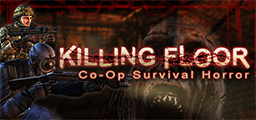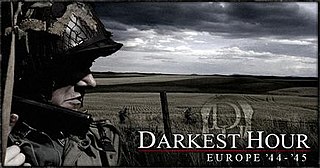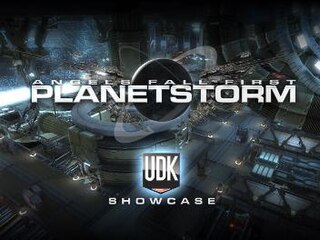
Unreal is a first-person shooter video game developed by Epic MegaGames and Digital Extremes and published by GT Interactive for Microsoft Windows in May 1998. It was powered by Unreal Engine, an original game engine. The game reached sales of 1.5 million units by 2002.

Battlefield 1942 is a 2002 first-person shooter video game developed by DICE and published by Electronic Arts for Microsoft Windows and Mac OS X. The game can be played in single-player mode against the video game AI or in multiplayer mode against players on the Internet or in a local area network. It is a popular platform for mod developers, with many released modifications that alter the gameplay and theme.

Unreal Tournament is a first-person arena shooter video game developed by Epic Games and Digital Extremes. The second installment in the Unreal series, it was first published by GT Interactive in 1999 for Microsoft Windows, and later released on the PlayStation 2 and Dreamcast by Infogrames in 2000 and 2001, respectively. Players compete in a series of matches of various types, with the general aim of out-killing opponents. The PC version supports multiplayer online or over a local area network. Free expansion packs were released, some of which were bundled with a 2000 re-release: Unreal Tournament: Game of the Year Edition.

Unreal Tournament 2003 is a first-person arena shooter video game developed by Epic Games and Digital Extremes, and published by Infogrames under the Atari brand name. The game is part of the Unreal franchise, and is a sequel to 1999's Unreal Tournament. Like its predecessor, the game is designed mainly for multiplayer gaming.

Unreal Tournament 2004 is a first-person arena shooter video game developed by Epic Games and Digital Extremes. Part of the Unreal franchise, it is the third game in the Unreal Tournament series and the sequel to Unreal Tournament 2003.

Unreal Tournament 3 (UT3) is a first-person arena shooter video game developed by Epic Games and published by Midway Games. Part of the Unreal franchise, it is the fourth game in the Unreal Tournament series, and the eighth game overall; its name is in reflection of the game being the first in the franchise to use Unreal Engine 3. It was released on November 19, 2007, for Microsoft Windows, December 11 for the PlayStation 3, and on July 3, 2008, for the Xbox 360. OS X and Linux ports were planned, but they were eventually cancelled.
Tripwire Interactive LLC is an American video game developer and publisher based in Roswell, Georgia.
Red Orchestra may refer to:

Ryan C. Gordon is a computer programmer and former Loki Software employee responsible for icculus.org, which hosts many Loki Software projects as well as others. Gordon's site hosts projects with the code from such commercial games as Duke Nukem 3D, Shadow Warrior, Quake III Arena and other free and open source projects for multiple platforms.

Mare Nostrum is a multiplayer team-based first-person action video game by American developer Sandstorm Productions, created as a total conversion modification of Red Orchestra: Ostfront 41-45.

Killing Floor is a cooperative first-person shooter video game developed and published by Tripwire Interactive. It was originally released as an Unreal Tournament 2004 mod in 2005. A full retail release followed on May 14, 2009, for Microsoft Windows, and for OS X on May 5, 2010. The Linux version was released on the Steam platform in November 2012. A sequel, Killing Floor 2, was announced on May 8, 2014, and released on November 18, 2016, worldwide.

Red Orchestra 2: Heroes of Stalingrad and Rising Storm GOTY, now known as Rising Storm/Red Orchestra 2 GOTY on Steam, is a tactical multiplayer first-person shooter video game set during World War II, developed and published by Tripwire Interactive. It is a sequel to Red Orchestra: Ostfront 41-45. The title focuses heavily on the Battle of Stalingrad and the Pacific Theater. The game was released in September 2011. The game is currently a Windows exclusive and contains many new features compared to the original, including a new first-person cover system, which can also be combined with blind firing, first person collision detection, Commander role and abilities as well as an entirely new system of statistics tracking and player levelling. Maps are much bigger and had immediate 64-player support.

Darkest Hour: Europe '44-'45 is a free modification developed by Darklight Games, and The Darkest Hour Team for Tripwire Interactive's multiplayer first-person shooter video game Red Orchestra: Ostfront 41-45, It is based on the Western Front during World War II between 1944 and 1945, depicting the conflict between Allied and German forces. Several large-scale operations are covered, including the invasion of Normandy, Battle of the Bulge, Operation Market Garden, and Battle of the Hürtgen Forest.

Angels Fall First is a first-person multiplayer shooter by British studio Strangely Interactive, combining game-play elements of traditional squad-based shooters with space combat games, with a particular focus on the ability to pilot and crew capital ships, which also serve as infantry combat settings themselves. Previously a mod of Epic Games' first-person shooter Unreal Tournament 3 and referred to as Angels Fall First: Planetstorm, the game has since been moved to the Unreal Development Kit and was released on Steam's Early Access on 10 October 2015 with its current title.

Rising Storm is a stand-alone expansion pack to Red Orchestra 2: Heroes of Stalingrad developed by Tripwire Interactive in conjunction with the modding community. The title focuses on the Pacific campaign of World War II. Announced in May 2010, the game was scheduled for release in 2013. The beta went live on May 8 that year. A sequel, titled Rising Storm 2: Vietnam was released in 2017.

Alien Swarm is a multiplayer top-down shooter video game developed by Valve. It is a remake of a mod for Unreal Tournament 2004, and it was developed by the original team, who were hired by Valve during the course of the development process.
Make Something Unreal, also known as $1,000,000 Make Something Unreal Contest and Make Something Unreal Live, is a series of video game development competitions organised by Epic Games which began in 2004, with subsequent competitions in 2008, 2012, and 2013. The contests aimed to reward developers who created mods using the Unreal game engine.

Killing Floor 2 is a first-person shooter video game developed and published by Tripwire Interactive, with later support from Saber Interactive. It is a sequel to 2009's Killing Floor. An early access version of the game was released for Microsoft Windows in April 2015, and the game was released in November 2016 for Windows and PlayStation 4 and August 2017 for Xbox One. The game utilizes Epic Games' Unreal Engine 3.

Rising Storm 2: Vietnam is a 2017 multiplayer tactical first-person shooter video game developed by Antimatter Games and Tripwire Interactive and co-published by Tripwire Interactive and Iceberg Interactive. It is a direct sequel to 2013's Rising Storm and is set during the Vietnam War. The game was released worldwide for Microsoft Windows through digital distribution platform Steam on May 30, 2017.


















